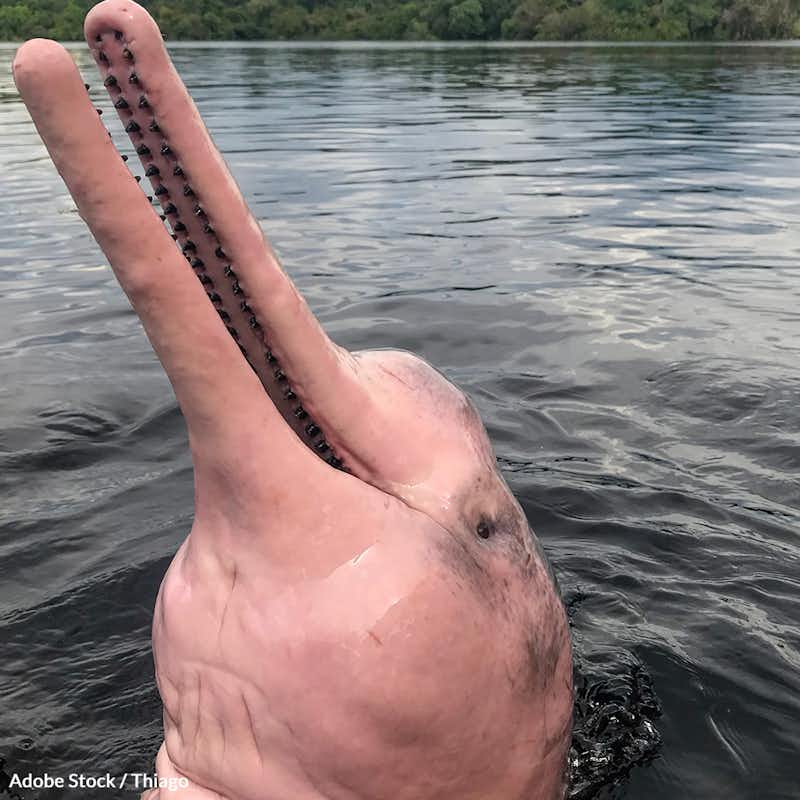Dams Risk Amazon Dolphins' Extinction — Act Now
26,023 signatures toward our 50,000 Goal
Sponsor: The Rainforest Site
Freshwater dolphins are bring pushed closer to extinction. Help us call for an end to dams on the Amazon and protect dolphins!

More than 400 hydroelectric dams are in operation, being built, or planned for the Amazon river's headwaters and basin1.
These dams disrupt water flow and nutrient deposition, with negative consequences for aquatic animals, especially migratory species like dolphins. As dams are constructed, the dynamite and noise can harm river dolphins. Once the dam is up, increased boat traffic can lead to more injuries and deaths from collisions2.
Two freshwater species: the Amazon River Dolphin and the Tucuxi, can be found in Brazil, Peru, Ecuador, and Colombia, and in the case of the Amazon River Dolphin, Bolivia and Venezuela3. The dolphins of the Amazon river have been listed as "Endangered" by the International Union for Conservation of Nature (IUCN) in its latest "Red List" published in November 20184.
A study conducted by researchers from the Instituto Nacional de Pesquisas da Amazonia in Manaus, Brazil, showed that freshwater dolphins found in the Amazon River Basin were "dying off fast," and could face extinction unless they were more vigorously protected5.
At the time of the study, the IUCN had listed the freshwater dolphins' status as "data deficient," meaning not enough was known about their numbers in the wild to assess the degree of threat to the population. But the study exposed enough evidence to convince the IUCN to change its classification of the animals6.
Hydroelectric dams have already split up the Amazon River Dolphin into several groups on the Tocantins River, which could increase if more dams are constructed. This isolation makes the dolphin population more vulnerable to future environmental impacts, such as those brought by climate change, disease, or more dams7.
Fragmentation and habitat degradation caused by dams have contributed to the decline of both the Ganges River Dolphin and the Yangtze River Dolphin, with the latter now likely to be functionally extinct8.
Several countries have classified the the Amazon River Dolphin and the Tucuxi at the national level9. This may protect the species from being regularly slaughtered by fishermen for use as bait, but it will not stop the decline of the species if the Amazon's tributaries are dammed up.
There needs to me an immediate moratorium on future large dams in the Amazon basin given their grave impacts on the region's ecosystems.
Take a stand for the dolphins of the Amazon. Sign the petition and call for the governments of the Amazon River Basin to place a moratorium on future dam building and protect these animals from extinction.
- David Hill, The Guardian (6 May 2014), "More than 400 dams planned for the Amazon and headwaters."
- World Wildlife Fund (14 August 2014), "4 Species Impacted by Dams."
- Luis Jaime Acosta, Reuters (27 January 2021), "Amazon River tucuxi dolphins at risk of disappearing, say environmentalists."
- IUCN — SSC Cetacean Specialist Group (November 2018), "35 Updated Cetacean Red List Assessments published in Nov 2018 ."
- Vera M. F. da Silva, Carlos E. C. Freitas, Rodrigo L. Dias, Anthony R. Martin, PLoS ONE (2 May 2018), "Both cetaceans in the Brazilian Amazon show sustained, profound population declines over two decades."
- DownToEarth (3 May 2018), "Amazon River Dolphins face extinction risk: Study."
- Mariana Paschoalini, Rafael M. Almeida, Fernando Trujillo, Fundación Omacha, PLoS ONE (April 2020), "On the brink of isolation: Population estimates of the Araguaian river dolphin in a human-impacted region in Brazil."
- Sibélia Zanon, Mongabay (21 April 2021), "Dams drove an Asian dolphin extinct. They could do the same in the Amazon."
- World Wildlife Fund (2022), "Freshwater dolphin species and facts."
The Petition:
To the Presidents of Brazil, Peru, Ecuador, Colombia, Bolivia and Venezuela,
Two freshwater species of freshwater dolphin that habitat in your countries: Amazon River Dolphin and the Tucuxi, have been listed as "Endangered" by the International Union for Conservation of Nature (IUCN) since its latest "Red List" published in November 2018.
However, these species are still being forced toward extinction at an alarming rate.
The dams your countries support in the Amazon River Basin disrupt water flow and nutrient deposition, with negative consequences for aquatic animals, especially migratory species like dolphins. As dams are constructed, the dynamite and noise can harm river dolphins. Once the dam is up, increased boat traffic can lead to more injuries and deaths from collisions with boats.
What remains of these dolphins has been fragmented into small groups in the once free-flowing Amazon. The construction of future dams will only ensure their complete demise.
There needs to be an immediate moratorium on future large dams in the Amazon basin given their grave impacts on the region's ecosystems.
Clean energy alternatives to hydroelectricity and energy efficiency measures are the only way we will save the freshwater dolphins of the Amazon.
I implore you to place a moratorium on future dam construction in the interest of protecting the Amazon River Dolphin and the Tucuxi from extinction.
Sincerely,
 Welcome Back! Log In to Continue
Welcome Back! Log In to Continue